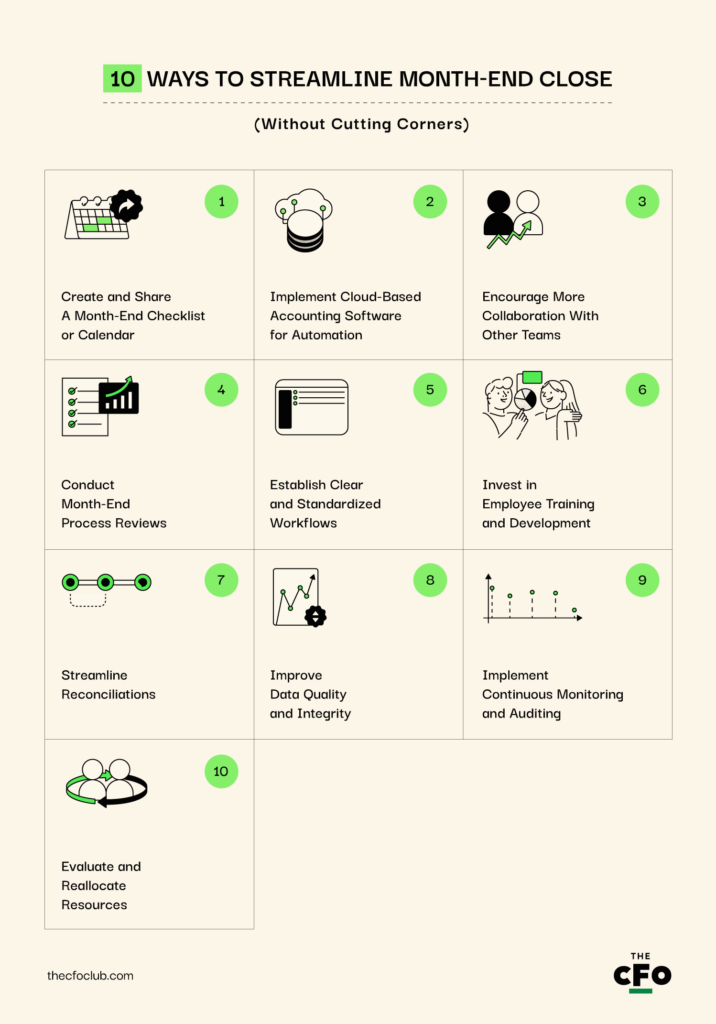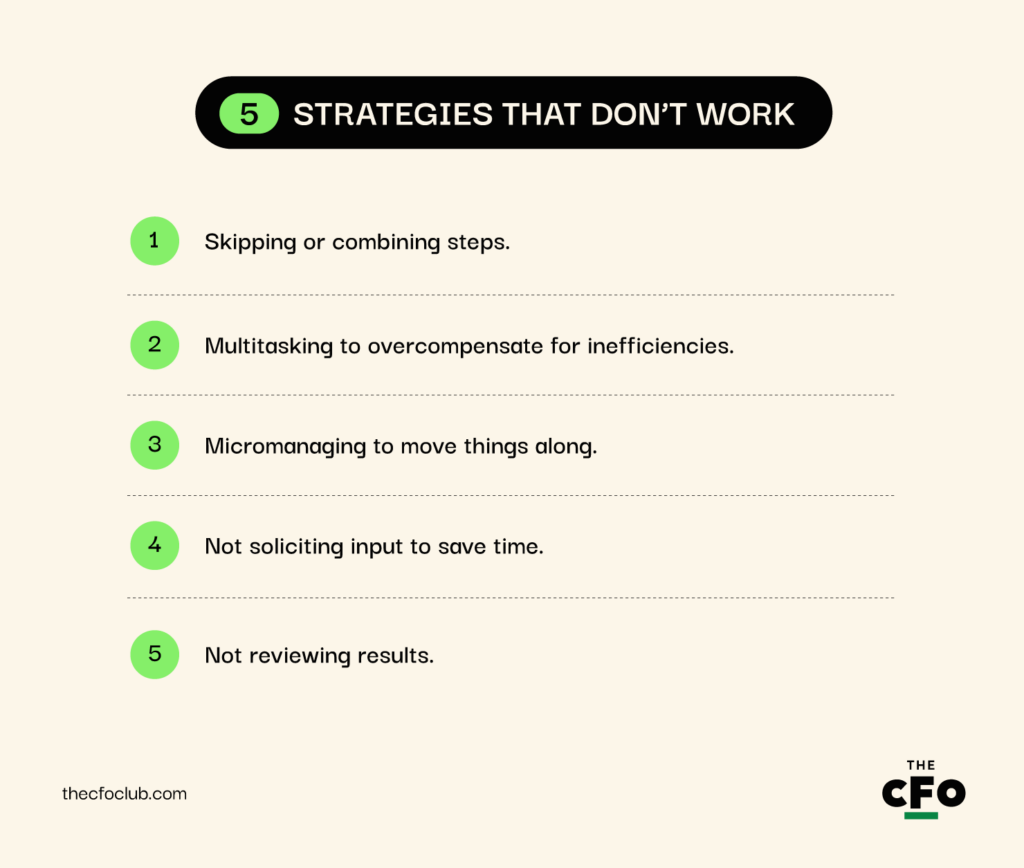Limited resources, lack of process standardization, manual workarounds, poor coordination, data inaccuracy… sound familiar? You aren’t alone. These are the things that make the month-end close a royal pain in the… rear.
We’ve already covered how to create an ongoing month-end close checklist, so I wanted to focus on ten other ways to sustainably streamline month-end—without cutting corners.
- Preparing monthly balance sheets
- Preparing income statements
- Reconciling bank statements
- Entering journal entries
- Assessing cash flow
Let’s take a closer look at each.

1. Create and Share a Month-End Checklist or Calendar
It sounds obvious, but it isn't. Poor month-end coordination is a challenge at the best of times. Keeping every month-end process running smoothly requires precise and timely coordination and organization.
As someone who's led accounting and financial reporting teams, all I can say is this: If I had a shiny nickel for every time I’ve had to send out reminders about missed deadlines and tasks—you get the gist.
Fortunately, this is fixable.
Month-end close calendars are vital, whether it's in the form of a checklist, a Google calendar, or an automated reminder as part of broader accounting software. Do this:
- Create an easy-to-update calendar
- Add month-end tasks
- Set due dates
- Invite assignees
- Automate reminders
You’re keeping Accounts Payable (AP), Accounts Receivable (AR), your financial reporting team, and everyone else involved accountable, more productive, and on the same page at the end of the month. This saves everyone tons of time and frustration.
| Effort required | Impact |
| Medium (Set up once and modify as needed). | High |
2. Implement Cloud-Based Accounting Software for Automation
Manual processes and workarounds are time-consuming. Cloud-based accounting and automation of functions like AP and AR enable team members to work from anywhere, improving flexibility and efficiency and reducing manual effort and errors. This means streamlined tasks, time savings, and team members who can complete higher-value work.
Streamlining your month-end close process using cloud-based accounting software provides these benefits:
- Fast and accurate data entry
- Simplified account reconciliations
- Easy report generation
- Automated tasks and reminders
- Real-time data
- Centralized financial data
- Remote access
- Integration with other systems
| Effort required | Impact |
| Medium (Cloud-based accounting software is often onboarded with minimal disruption and maintenance to your business). | High |
3. Encourage More Collaboration With Other Teams
Poor coordination of effort slows down your month-end process and reduces resourcing efficiency. Increased collaboration between departments is critical to a successful month-end close. Your team's performance depends on collaboration with other functional units and external regulators, suppliers, or vendors.
When everyone is aligned, working towards common goals, and informed about the progress of the close process, it helps your team resolve issues promptly and minimize delays at the end of each month. Do this:
- Establish clear communication
- Encourage more collaboration between departments and other parties
- Encourage regular meetings or check-ins
| Effort required | Impact |
| Low | High |
4. Conduct Month-End Process Reviews
If your month-end accounting processes aren't working as expected or are outdated, you will need to identify areas for improvement and reimagine your month-end close process as a whole. Do this:
- Allocate time after each accounting period to evaluate the effectiveness of the implemented strategies
- Identify any shortcomings or oversights
- Review the documented processes
- Get feedback from team members or others involved in the process
- Based on the feedback, make necessary adjustments to streamline processes
| Effort required | Impact |
| Medium | High |
5. Establish Clear and Standardized Workflows
Unstandardized workflows can create inconsistencies and room for error within your month-end process. Streamlining your accounting workflows is crucial if you're looking for a more efficient month-end close.
Another part of streamlining your month-end close involves securing data, ensuring consistency, and improving communication to eliminate silos and ambiguity, reduce redundancy, and improve overall efficiency. Do this:
- Review all existing processes
- Identify tasks that can safely be eliminated or modified to save time and effort
- Optimize workflows to eliminate bottlenecks and improve efficiency
- Standardize your procedures
- Document and share all workflow steps, responsibilities, and deadlines
| Effort required | Impact |
| High | High |
6. Invest in Employee Training and Development
Not having the right skills or knowledge can result in resourcing issues that impact your month-end close. Investing in employee training and development is crucial for streamlining the month-end close process. Well-trained and knowledgeable employees are more efficient and can contribute effectively to the close process.
Investing in your team's training and development gives them the necessary skills and knowledge to streamline the month-end close process effectively and tells them their work matters. Do this:
- Ensure that your finance team is trained and proficient in using accounting software
- Give them access to reporting tools and other automation tools to help others and themselves use an accounting system to its full potential
- Ensure your team is current on accounting principles and best practices to ensure they have a solid foundation to perform their tasks accurately and efficiently
| Effort required | Impact |
| Low | High |
7. Streamline Reconciliations
Reconciling accounts is essential to the month-end close process, but manual reconciliation can be time-consuming and prone to errors. It’s also boring as heck, burning out your team and leading to increased frustration and higher turnover.
Having an automated and streamlined reconciliation process can significantly improve efficiency and accuracy. Do this:
- Leverage tools that automatically match transactions
- Identify discrepancies and highlight exceptions to reduce time and effort and ensure accuracy and completeness
- Prioritize high-risk or high-impact accounts for reconciliation. Not all accounts require the same level of scrutiny during the month-end close process
- Establish clear reconciliation guidelines and procedures
- Ensure all team members follow a standardized approach to reduce errors and inconsistencies and improve accuracy
| Effort required | Impact |
| Medium | High |
8. Improve Data Quality and Integrity
Data quality and integrity are crucial for accurate financial records, decision-making, and setting and analyzing growth metrics accurately. By ensuring that data is clean, complete, and consistent, your team can streamline the monthly close process and avoid delays and errors.
Enhancing data quality and integrity helps your team streamline the month-end close process and ensure accurate financial reporting. Do this:
- Implement data validation checks to identify and correct any data entry errors or inconsistencies
- Leverage automation tools that validate data against predefined rules and highlight any discrepancies
- Cleanse and update your data regularly to maintain its integrity
- Identify and address any duplicate, outdated, or irrelevant data
| Effort required | Impact |
| Low | High |
9. Implement Continuous Monitoring and Auditing
Stale processes and practices pave the way for poor performance. Continuous monitoring and auditing can significantly streamline the month-end close process by identifying errors and discrepancies early on.
Do this:
- Leverage technology to monitor transactions and accounts in real-time
- Implement automated alerts and notifications that highlight potential errors or discrepancies
- Conduct regular internal audits to ensure compliance with accounting standards and regulatory requirements
| Effort required | Impact |
| Low | High |
10. Evaluate and Reallocate Resources
The month-end close process is not new or specific to your company, but your resources may be. Ensuring each individual is in the right role reduces fatigue, boredom, and turnover while increasing productivity, job satisfaction, accountability, and investment in the work.
You should look at your department structure annually and reevaluate and reallocate your resources to ensure you have the best-suited people working on specific tasks.
Evaluate these:
- Education and training
- Skills and capabilities
- Areas of interest
- Career goals
- Job satisfaction
- Individual performance
| Effort required | Impact |
| Medium | High |
5 Strategies That Don't Work

Focusing solely on ways to reduce the time it takes to get work done can lead to unintended results, like missed steps, disgruntled employees, and overburdened teams. These are five strategies that just don't work when it comes to streamlining month-end close.
Skipping or Combining Steps
It may be tempting to skip month-end close steps or combine them. The trouble is that when you do this, here's what's likely to happen:
- Something important is missed
- Costly mistakes
- Financial statements end up incorrect
- Work is often doubled up for you and others down the road
Recognize that steps in a process are likely in place for a reason. Before arbitrarily making changes, carefully review each step to determine why it may or may not be needed and discuss it with the CFO and others impacted.
Multitasking to Overcompensate for Inefficiencies
Accounting teams are often erroneously seen as cost centers and expected to multitask and do more with less. It's important to recognize the vital contributions of these essential resources and equip them with what they need to get the work done on time.
Instead of using multitasking to overcompensate for inefficiencies, ensure your accounting teams have the tools to be more efficient, rather than working them harder and increasing employee burnout.
Month-end close can be grueling if things aren’t organized, so make sure you adjust your vacation accruals to give your team time to rest before the next cycle.
Micromanaging to Move Things Along
Micromanaging is another mistake I have seen (and experienced) far too often in accounting departments. While keeping a closer eye on your employees appears to give you more control over the month-end process, it accomplishes the opposite.
Trust that you've hired the right people with the right skill sets and capabilities, then simply provide them with the information and tools to excel.
Not Soliciting Input to Save Time
It may seem as though waiting for feedback from other teams or stakeholders slows down your month-end process; while it may initially do so, in the long run, this feedback and buy-in from other business areas helps you improve processes by having all the financial information you need for better decision-making.
Talk with other stakeholders and subject-matter experts about why you need certain information, make sure they’re actually bought in, then ask them to assist you in streamlining your processes.
Not Reviewing Results
Month-end is an exhausting time for most accounting teams. By the time everything is complete, the last thing you may feel like doing is analyzing all the results in detail. But here’s the thing: this is an important step in streamlining your end-to-end processes and producing better results in the future—so by not doing it, you’re creating more work for yourself.
Take the time to review the month-end results and financial reports. This will benefit your team by isolating issues faster and honing your team's skills for next month. It will also provide the entire company with the information needed to make better business decisions faster.
Subscribe For More Accounting Cycle Insights
Being an effective accounting leader means more than just going through the motions with month-end close tasks. It may be burdensome, but it’s your burden to shoulder.
Ready to compound your abilities as an accounting leader? Subscribe to our free newsletter for expert advice, guides, and insights from finance leaders shaping the tech industry.



